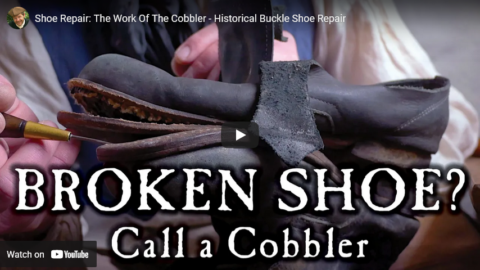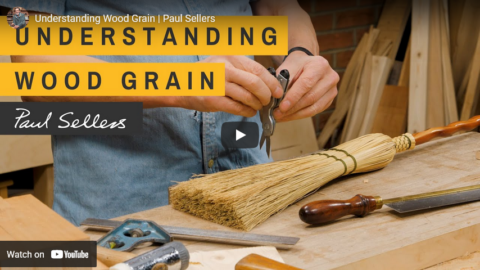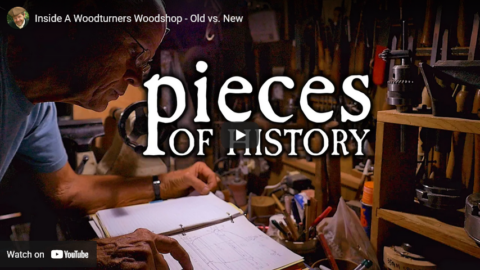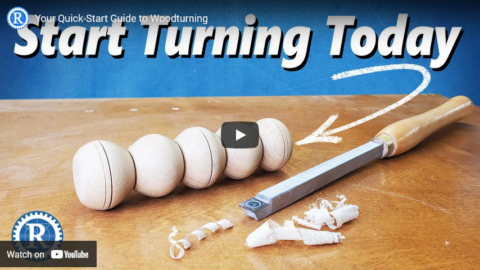Paul Sellers
Published 7 Oct 2022Take the guesswork out of truing up a twisted board by setting lines that guarantee dead-on accuracy. When we buy wood, it is often too twisted to work with, so we must remove the twist, cup, and bow.
This quick tip gives you lines to work to with only minimal measuring and a positive outcome.
(more…)
February 16, 2023
Twist Solution | Paul Sellers
February 9, 2023
Get flat boards EVERY TIME with this simple process // Handtool stock-prep
Rex Krueger
Published 8 Feb 2023Flattening by hand can be intimidating, unless you have a process.
(more…)
February 8, 2023
Hand Planing Awkward Grain | Paul Sellers
Paul Sellers
Published 21 Oct 2022We are often taught to plane in one direction or the other, planing along the grain, but some grain is better planed across the long axis to counter reverse grain caused by the roots of knots in the wood. This goes against the grain with many woodworkers, and yet it can be a perfect solution to get a really good surface.
I am not saying it works every time but more often than you might think; it puts you in the driving seat when wood seems to defy conventional means of planing.
(more…)
January 25, 2023
January 1, 2023
Full Cabin Build – 4K Full Length – Townsends Wilderness Homestead
Townsends
Published 29 Aug 20220:00 – Laying the Foundation
4:39 – The Walls Begin
8:22 – Prepping the Fireplace
9:52 – Finishing the Walls
15:58 – The Roof Design
17:04 – Adding the Purlins
20:29 – The Doorframe
21:32 – The Final Purlins
24:00 – Roofing Materials
25:47 – Adding the Bark Shingles
27:37 – Roof Wrap-Up
29:03 – Door Jams
29:47 – Opening the Fireplace
30:58 – Building the Fireplace
36:06 – Adding the Door
37:54 – The First Fire
39:02 – A Winter Safe Haven
(more…)
November 24, 2022
Can I make an AUTHENTIC Katana from wood?
Rex Krueger
Published 23 Nov 2022Historical weapon, beautiful construction & a great holiday gift, Katanas have it all!
Patrons get all plans early: http://www.patreon.com/rexkrueger
Get the FREE templates!: https://www.rexkrueger.com/store (scroll down to bottom of page).
(more…)
November 2, 2022
Essential Wood Finishes | Paul Sellers
Paul Sellers
Published 1 Jul 2022When it comes to wood finishes, for most, it is like watching paint dry, but we woodworkers must come up with something that makes our work look good, has durability, and is generally easy to apply. Over the years, I have tried most, and the two I lean on the most are shellac and water-based clear varnishes.
Chemicals as solvents used in paints have harmful effects, and we have become more conscious of the problems they cause. I wanted to let people know what I use in the day-to-day.
These two are the ones I rely on the most, but I do use other finishes from time to time.
(more…)
July 14, 2022
July 12, 2022
Shoe Repair: The Work Of The Cobbler – Historical Buckle Shoe Repair
Townsends
Published 21 Mar 2022Our Brand New Viewing Experience ➧ https://townsendsplus.com/ ➧➧
Retail Website ➧ http://www.townsends.us/ ➧➧
Help support the channel with Patreon ➧ https://www.patreon.com/townsend ➧➧
Instagram ➧ townsends_official
June 30, 2022
Understanding Wood Grain | Paul Sellers
Paul Sellers
Published 4 Mar 2022Grain for most people is the look wood has in its diverse colour and configuration. For the woodworker, grain is the inner depth that must be worked with saws, chisels, and planes, and the understanding reinforces the way the wood must always be worked to work “with” the grain rather than against it.
Paul put this video together to help bridge the gap of information between the observer, who needs only to see and feel, and the maker, who must understand how the fibre of wood works like the material in their life.
——————–
Want to learn more about woodworking?
Go to Woodworking Masterclasses for weekly project episodes: http://bit.ly/2JeH3a9
Go to Common Woodworking for step-by-step beginner guides and courses: http://bit.ly/35VQV2o
http://bit.ly/2BXmuei for Paul’s latest ventures on his blog
——————–
Instagram: http://bit.ly/2oWpy7W
Twitter: http://bit.ly/33S7RFa
Pinterest: http://bit.ly/35X5uTf
June 17, 2022
May 23, 2022
Inside A Woodturners Woodshop – Old vs. New
Townsends
Published 16 May 2022Gen Nis He Yo Trading Company ➧ http://gennisheyotrading.com/ ➧➧
Our Brand New Viewing Experience ➧ https://townsendsplus.com/ ➧➧
Retail Website ➧ http://www.townsends.us/ ➧➧
Help support the channel with Patreon ➧ https://www.patreon.com/townsend ➧➧
Instagram ➧ townsends_official
April 28, 2022
Work ANYWHERE with New Tools and Smart Techniques
Rex Krueger
Published 27 Apr 2022No shop is no problem with just a couple tools & a little ingenuity.
Patrons get all plans for FREE: http://www.patreon.com/rexkrueger
Build the Lightweight Traveler’s Bench & Japanese Sawhorses (Links Below)Lightweight Traveler Workbench
Plans: https://www.woodworkforhumans.com/sto…
Video: https://youtu.be/lPiMjv7lkqIJapanese Sawhorses
Plans: https://www.rexkrueger.com/store/2d7p…
Video: https://youtu.be/j7O7Efrzvv0How to Set Up a Chinese Plane (Old Video): https://www.youtube.com/watch?v=tZkb_…
______________________________________________Tools in this video (Affiliate):
Chinese Jack Plane: https://amzn.to/3vtWCUh
This one is my favorite. It’s made of a very hard wood and the handle is high and easy to grip. The one in this video is the 280mm model and I set it up for aggressive work.Chinese Smoothing Plane: https://amzn.to/37GJxOk
This one is the same length as the one above, and it has a lower handle and the wood is a bit softer. Still a fine plane for the money. The only reason I call this my “smoothing” plane is that I set it up for fine work. A shorter plane would probably make an even better smoother.Japanese Ryoba Saw: https://amzn.to/3kfcCD5
Many Ryobas are very good. This is my favorite of the 4-5 I’ve tried.
______________________________________________Get My New Book, Everyday Woodworking: https://amzn.to/3oyjC0E
Check out my new site: https://woodworkforhumans.com
______________________________________________Sign up for Fabrication First, my FREE newsletter: http://eepurl.com/gRhEVT?
______________________________________________Wood Work for Humans Tool List (affiliate):
*Cutting*
Gyokucho Ryoba Saw: https://amzn.to/2Z5Wmda
Dewalt Panel Saw: https://amzn.to/2HJqGmO
Suizan Dozuki Handsaw: https://amzn.to/3abRyXB
(Winner of the affordable dovetail-saw shootout.)
Spear and Jackson Tenon Saw: https://amzn.to/2zykhs6
(Needs tune-up to work well.)
Crown Tenon Saw: https://amzn.to/3l89Dut
(Works out of the box)
Carving Knife: https://amzn.to/2DkbsnM
Narex True Imperial Chisels: https://amzn.to/2EX4xls
(My favorite affordable new chisels.)
Blue-Handled Marples Chisels: https://amzn.to/2tVJARY
(I use these to make the DIY specialty planes, but I also like them for general work.)*Sharpening*
Honing Guide: https://amzn.to/2TaJEZM
Norton Coarse/Fine Oil Stone: https://amzn.to/36seh2m
Natural Arkansas Fine Oil Stone: https://amzn.to/3irDQmq
Green buffing compound: https://amzn.to/2XuUBE2*Marking and Measuring*
Stockman Knife: https://amzn.to/2Pp4bWP
(For marking and the built-in awl).
Speed Square: https://amzn.to/3gSi6jK
Stanley Marking Knife: https://amzn.to/2Ewrxo3
(Excellent, inexpensive marking knife.)
Blue Kreg measuring jig: https://amzn.to/2QTnKYd
Round-head Protractor: https://amzn.to/37fJ6oz*Drilling*
Forstner Bits: https://amzn.to/3jpBgPl
Spade Bits: https://amzn.to/2U5kvML*Work-Holding*
Orange F Clamps: https://amzn.to/2u3tp4X
Screw Clamp: https://amzn.to/3gCa5i8Get my woodturning book: http://www.rexkrueger.com/book
Follow me on Instagram: @rexkrueger
April 21, 2022
Your Quick-Start Guide to Woodturning
Rex Krueger
Published 20 Apr 2022Now that you’ve got a woodturning lathe, make this easy foot-massager in a few hours.
Patrons get all plans for free: http://www.patreon.com/rexkrueger
Get One Week to Woodturning: https://www.rexkrueger.com/store/one-…Get One Week to Woodturning on Kindle: https://tinyurl.com/unbbfyym
———————————————————————
Your First Lathe Unoxing/Setup
https://youtu.be/NRmB0uw4yDgTurn a Firewood Bowl
https://youtu.be/oVhWO4zi3aEWoodturning Playlist
https://youtube.com/playlist?list=PLR…______________________________________________
Get My New Book, Everyday Woodworking: https://amzn.to/3oyjC0E
Check out my new site: https://woodworkforhumans.com
______________________________________________Sign up for Fabrication First, my FREE newsletter: http://eepurl.com/gRhEVT?
______________________________________________Wood Work for Humans Tool List (affiliate):
*Cutting*
Gyokucho Ryoba Saw: https://amzn.to/2Z5Wmda
Dewalt Panel Saw: https://amzn.to/2HJqGmO
Suizan Dozuki Handsaw: https://amzn.to/3abRyXB
(Winner of the affordable dovetail-saw shootout.)
Spear and Jackson Tenon Saw: https://amzn.to/2zykhs6
(Needs tune-up to work well.)
Crown Tenon Saw: https://amzn.to/3l89Dut
(Works out of the box)
Carving Knife: https://amzn.to/2DkbsnM
Narex True Imperial Chisels: https://amzn.to/2EX4xls
(My favorite affordable new chisels.)
Blue-Handled Marples Chisels: https://amzn.to/2tVJARY
(I use these to make the DIY specialty planes, but I also like them for general work.)*Sharpening*
Honing Guide: https://amzn.to/2TaJEZM
Norton Coarse/Fine Oil Stone: https://amzn.to/36seh2m
Natural Arkansas Fine Oil Stone: https://amzn.to/3irDQmq
Green buffing compound: https://amzn.to/2XuUBE2*Marking and Measuring*
Stockman Knife: https://amzn.to/2Pp4bWP
(For marking and the built-in awl).
Speed Square: https://amzn.to/3gSi6jK
Stanley Marking Knife: https://amzn.to/2Ewrxo3
(Excellent, inexpensive marking knife.)
Blue Kreg measuring jig: https://amzn.to/2QTnKYd
Round-head Protractor: https://amzn.to/37fJ6oz*Drilling*
Forstner Bits: https://amzn.to/3jpBgPl
Spade Bits: https://amzn.to/2U5kvML*Work-Holding*
Orange F Clamps: https://amzn.to/2u3tp4X
Screw Clamp: https://amzn.to/3gCa5i8Get my woodturning book: http://www.rexkrueger.com/book
Follow me on Instagram: @rexkrueger
From the comments:
Rex Krueger
4 hours ago
I am NOT posting a link to the carbide tools from this video because I hate them. They are cheap and low quality and I do not recommend them. If you’d like to suggest some good carbide tools, feel free to mention them in the comments. Thanks!









